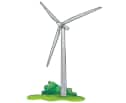NCERT Solutions for Class 6 Science Chapter 11 - Nature's Treasure
The NCERT Solutions for Class 6 Science Chapter 11 Nature’s Treasures teach students the importance of natural resources. Different ways of protecting the natural resources, like trees, air, water, minerals, and animals, are included. The answers are prepared by subject experts in simple and easy-to-understand language, along with well-labeled diagrams, which makes learning more effective. The NCERT Solutions serve as a guide for completing homework, doing revisions, and increasing confidence during exams.
This Story also Contains
- Download Nature’s Treasures Class 6 Questions and Answers PDF
- Access the Class 6 Science Chapter 11 Nature’s Treasures Question Answer
- Approach to Solve Nature’s Treasures Class 6 Question Answer
- Important Topics of Nature’s Treasures Class 6 NCERT Chapter 11
- Important Questions from Nature’s Treasures Class 6 NCERT Chapter 11
- What You Will Learn From Nature’s Treasures NCERT Solutions?
- Why Class 6 Science Chapter 11 Nature’s Treasures NCERT Solutions are Important?
- NCERT Solutions for Class 6 Science: Chapter-wise
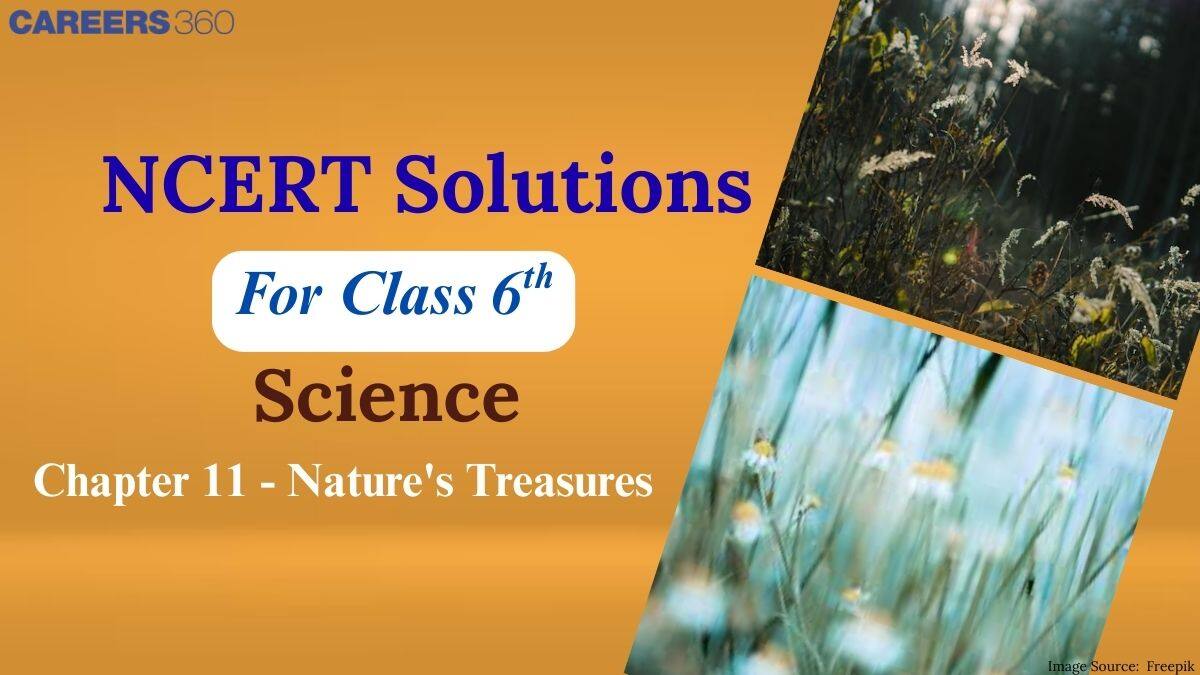
Nature’s Treasures Class 6 question answer explores the different ways of protecting nature. This deals with the use of fewer vehicles, planting trees, saving water, and following the 3Rs. The difference between renewable and non-renewable resources is well-explained in the Nature’s Treasures chapter. Students can also download the Nature’s Treasures Class 6 questions and answers PDF for quick and effective revision, which follows the latest NCERT syllabus closely.
Download Nature’s Treasures Class 6 Questions and Answers PDF
Nature's Treasures helps learners explore how resources support life and ways to protect them. Students can download the Nature’s Treasures Class 6 questions and answers PDF from the link given below, and can use it offline for easy revision and homework. The answers in the NCERT Solutions Class 6 Science are written in clear language to make understanding easier and faster.
Access the Class 6 Science Chapter 11 Nature’s Treasures Question Answer
The detailed solutions to all the questions given in the textbook are provided below. Using the Class 6 Science Chapter 11 Nature’s Treasures question answer helps students increase their knowledge about resources and their conservation.
Question 1. Fig. shows items related to natural resources. Match them with their jumbled-up names. Make another table and write the names of these resources. Classify these resources as renewable or non-renewable.
Item | Jumbled name |
| atwre |
| ndiw |
| refost |
| ocrk |
Answer:
Item | Jumbled name | Unjumbled name | Renewable/ Non-renewable |
| atwre | Water | Renewable resource |
| ndiw | Wind | Renewable resource |
| refost | Forest | Renewable resource |
| ocrk | Rock | Non-Renewable resource |
Question 2. State whether the following statements are True [T] or False [F]. If False, correct them.
(i) Nature has all the resources to meet human needs. [ ]
(ii) Machines are a resource found in nature. [ ]
(iii) Natural gas is a non-renewable resource. [ ]
(iv) Air is a renewable resource. [ ]
Answer:
(i) The given statement is false.
Correct statement: Nature provides a wide variety of resources, but they are not sufficient to meet all human needs.
(ii) The given statement is false.
Correct statement: Machines are man-made resources and are not found in nature.
(iii) The third statement is true.
(iv) The given statement is true.
Question 3. Fill in the blanks using the most appropriate option-
(i) A fuel that is commonly used in two-wheelers like scooters or bikes is.........
(a) Kerosene
(b) Petrol
(c) Diesel
(d) LPG
(ii) An example of a renewable resource is ..................
(a) Coal
(b) Water
(c) Natural gas
(d) Petrol
Answer:
(i) A fuel that is commonly used in two-wheelers like scooters or bikes is Petrol.
(ii) An example of a renewable resource is Water.
Question 4. Classify the following as renewable or non-renewable resources: coal, natural gas, forests, and minerals.
Answer:
Renewable resources | Non-Renewable resources |
Forests | Coal, natural gas, minerals |
Question 5. Why do we say that petroleum is a non-renewable resource?
Answer:
We say that petroleum is a non-renewable resource because it takes millions of years to form, and humans cannot make petroleum instantly once it is used.
Petroleum is made from dead plants and animals that have been buried under the Earth for a very long time. When millions of years passed, the continuous effect of heat and pressure led to the formation of petroleum. After that, humans dug deep into the ground and took out the petroleum. But once this is used, we cannot make more in our entire lives. For this reason, petroleum is considered a non-renewable resource.
Question 6. It is difficult to regrow forests. Justify this statement.
Answer:
Plants take several years to grow into trees and form forests. When forests are cut down because of human activities, it is not easy to bring back all the trees, plants, and animals that lived there. Without trees, the soil becomes dry, which leads to soil erosion. Due to this, new plants may not grow well on the same land. Also, the place where the forest has been removed can be used for buildings and roads, so there is no space left to plant new trees. That is why it is hard to regrow forests.
Question 7. Make a list of five daily activities in which you use natural resources. Suggest ways by which you can reduce their use.
Answer:
Five daily activities in which we use natural resources, and how to reduce their use:
Brushing teeth – While we brush our teeth, we use water, which is a natural resource.
Way to reduce: Turn off the tap while brushing.Traveling to school – Vehicles that we use to reach school use petrol or diesel, which come from petroleum, a natural resource.
Way to reduce: If the school is nearby, we can walk or cycle.Using lights and fans – The Electricity that we use is either made from coal or water, and both are natural resources.
Way to reduce: Switch off lights and fans when not in use.Eating food – Food comes from plants, animals, and water, which are all natural resources.
Way to reduce: Don’t waste food and take only what you can eat.Using paper for homework – The Paper that we use for writing is prepared from trees.
Way to reduce: Both sides of the paper need to be used, and avoid wasting it.
Question 8. List four activities that are possible due to the presence of air.
Answer:
Four activities that are possible because of air:
Breathing – All living organisms need oxygen from the air for breathing and to stay alive.
Flying kites – Kites that we fly in the air are possible only due to the presence of air.
Sailing boats – Wind in the sails helps boats move forward.
Burning fire – For burning fire, air is required. Without air, fire is not possible.
Question 9. How can you contribute to enhancing the green cover of your locality? Make a list of actions to be taken.
Answer:
There are several steps that we can take to enhance the green cover around our locality, which are provided below:
1- Plant more trees in parks, gardens, and around our house.’
2- We need to stop cutting down plants and trees.
3- In our own home, on the balcony, we can grow some small plants.
4- Tree planting programs and drives can be promoted.
Question 10. In the given illustration, we see that food is being cooked. Answer the following questions-
(i) What type of energy is being used for cooking?
(ii) Name one benefit and one drawback of using this type of energy for cooking.
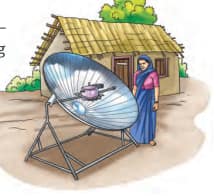
Answer:
(i) The above image is a woman standing beside a solar cooker. This solar cooker uses the energy from the sun to prepare a dish.
So, solar energy is the energy used for cooking.
(ii) Benefit: Solar cookers are eco-friendly and do not produce any smoke or harmful emissions, which is good for health as well as for the environment.
Drawback: This solar cooker is dependent on the sun. It cannot be used on cloudy or rainy days as well as at night.
Question 11. Cutting down trees on a large scale impacts the quality of the soil. Why do you think it is so?
Answer:
Cutting down trees on a large scale, known as deforestation, impacts the quality of the soil to a large extent. Roots of the trees hold the soil together; when these trees are removed, the soil becomes loose and can be blown away by wind or water that causing soil erosion. Also, without trees, the soil loses all its nutrients and becomes dry and less fertile, which decreases the growth of plants. That is why cutting down many trees makes the soil bad and weak.
Question 12. Explain two ways in which human activities pollute the air. Propose one action that can help in reducing air pollution.
Answer:
Two ways in which human activities pollute the air:
Smoke from vehicles such as cars, buses, and bikes releases harmful gases that lead to air pollution.
Burning waste and smoke from factories and industries release harmful gases into the atmosphere that cause air pollution.
One action that can help in reducing air pollution is:
Use public transport, walk, cycle, or carpool to reduce vehicle emissions.
Question 13. A family uses solar panels to generate electricity, a gas stove to cook food, and a windmill to pump water from a well. What would happen if there were no sunlight for a week?
Answer:
If there is no sunlight for a week, the family that uses solar panels to generate electricity would not get any electricity from the sun. They have to generate it by using different sources, like candles or batteries, for light.
But the gas stove will still work as usual, even though there is no sun, and they can cook food.
The windmill will work if there is wind, and it can pump water from the well.
Question 14. Fill up the blanks using the following terms: (fossil fuels, forest, air, petroleum, coal, water, and nonrenewable resource).
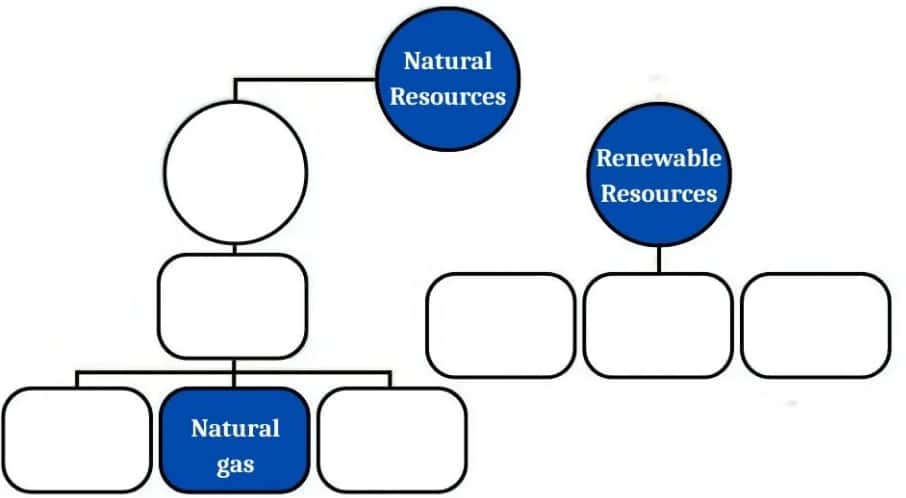
Answer:
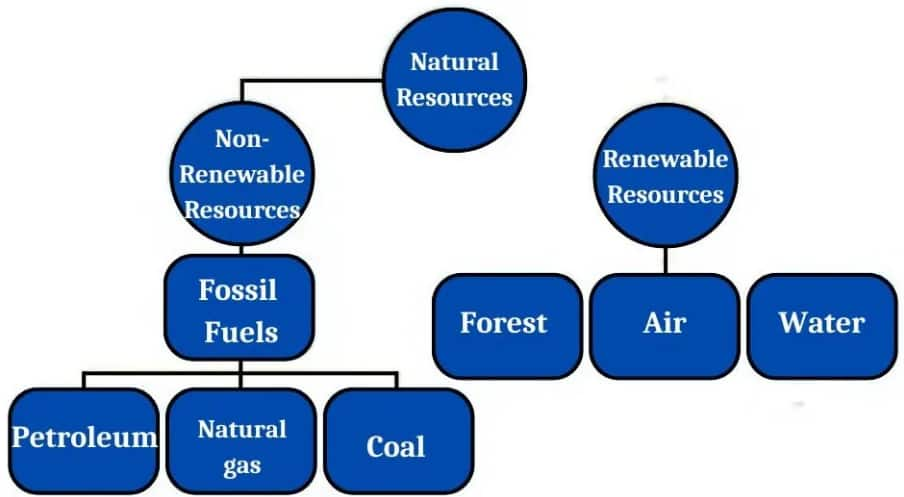
Question 15. There is an increasing demand for trees to meet the requirements of industries and housing. Therefore, trees are being felled. Is it justified? Discuss and prepare a brief report.
Answer:
Given below is a brief report on Cutting Down Trees for Industries and Housing
Introduction:
Yes, there is an increasing demand for trees to meet the requirements of industries and housing. But cutting down trees on a large scale will lead to serious effects on the environment.
Discussion:
There are some benefits and more problems due to deforestation, which are discussed below:
Benefits:
Trees are cut down for wood to make furniture, paper, building materials, and many other things. The land after the cutting of forests is then utilized for buildings and industries.
Problems: Cutting down trees leads to the loss of various animal and plant species that are living in those forests. Apart from this, deforestation leads to soil erosion, increasing temperature, more air pollution, etc.
Conclusion:
Only a minimum amount of forests need to be cut, and to replace this loss, more and more plants should be planted by each and every person to reduce deforestation.
Question 16. Propose a plan to use less water in your school. What steps would you take to make this plan happen, and how would it help the environment?
Answer:
To use less water in school and to conserve that, various steps can be followed, which are listed below:
1- We need to make sure that all the taps are checked and fixed if they are leaking. Leaky taps will lead to a large amount of water.
2- All students and teachers need to ensure that all taps are tightly closed after use.
3- Schools can set up a system to collect rainwater, and this water can be used for watering plants and cleaning purposes.
4- Campaigns need to be conducted to teach students the importance of water and how to save it.
How It Helps the Environment:
1- If we save water, it will be useful for future generations.
2- By conserving water, we can help maintain the balance of the ecosystem and all the processes that require water.
Approach to Solve Nature’s Treasures Class 6 Question Answer
The students can begin by reading the chapter to understand the importance of natural resources and biodiversity. Students can refer to the Class 6 Science Chapter 11 Nature’s Treasures question answer to make notes. They should make notes on renewable and non-renewable sources, and examples of flora and fauna. Practice diagrams and flow charts to have a visual memory given in the Class 6 Science Nature’s Treasures question answer. Finally, they can refer to the NCERT Solutions of Class 6 to relate the concepts to real-life examples, which makes their learning practical.
Also, check the NCERT Books and the NCERT Syllabus here
Important Topics of Nature’s Treasures Class 6 NCERT Chapter 11
This chapter helps students understand how nature supports life and why it is important to protect it. Given below are a few important topics of the Nature’s Treasures chapter. To gain clarity on these topics, students can use the NCERT Solutions for Class 6 Science Chapter 11 Nature’s Treasures.
Types of natural resources like air, water, soil, plants, and minerals
Importance of forests and their uses (wood, fruits, medicinal plants)
Need for conservation and sustainable use of natural resources
Methods to conserve resources in daily life
Difference between renewable and non-renewable resources
Important Questions from Nature’s Treasures Class 6 NCERT Chapter 11
Nature’s Treasures introduces the wide variety of resources found in our surroundings. It helps students understand the importance of conserving them for a sustainable future. Given below are a few important questions from this chapter. Students have to practice more questions provided in the NCERT Solutions for Class 6 Science Chapter 11 Nature’s Treasures to boost confidence.
Question 1: Which of the following are endangered animals, and what is a way to protect them?
Options:
(A) Cow and Goat; by increasing their breeding
(B) Bengal Tiger and Indian Rhinoceros; by protecting habitats and banning hunting
(C) Dog and Cat; by building more shelters
(D) Peacock and Elephant; by feeding them regularly
Answer: (B) Bengal Tiger and Indian Rhinoceros; by protecting habitats and banning hunting
Explanation: The Bengal tiger and Indian rhinoceros are endangered due to habitat loss and poaching. Conserving their natural environments and enforcing laws against hunting are effective ways to protect them.
Question 2: The Water cycle maintains the balance of water in nature. True or False
Options:
(A) True
(B) False
Answer: (A) True
Explanation: The Water cycle leads to the addition of lost water through rainfall or other precipitation methods. Hence, the given statement is true.
Question 3: The components present in the air are:
Options:
(A) Oxygen
(B) Nitrogen
(C) Both 1 and 2
(D) Aluminum
Answer: (C) Both 1 and 2
Explanation: Air is mainly made up of nitrogen and oxygen. Nitrogen forms the largest part, while oxygen is essential for breathing and burning.
Question 4: The Sun is the main source of energy for all living things on Earth. True or False
Options:
(A) True
(B) False
Answer: (A) True
Explanation: The Sun provides energy that plants use to make food through photosynthesis. This energy then passes to animals and humans through the food chain, making the Sun the ultimate source of energy.
Question 5: Why are forests called the “green lungs” of the Earth?
Options:
(A) Because they look green and beautiful
(B) Because they absorb carbon dioxide and release oxygen
(C) Because they are full of animals
(D) Because they get a lot of rainfall
Answer: (B) Because they absorb carbon dioxide and release oxygen
Explanation: Forests clean the air by taking in carbon dioxide and giving out oxygen during photosynthesis. This helps maintain the balance of gases in the atmosphere, keeping Earth healthy.
Question 6: Which of the following is a renewable natural resource?
Options:
(A) Coal
(B) Petroleum
(C) Solar energy
(D) Natural gas
Answer: (C) Solar energy
Explanation: Solar energy is renewable because it is continuously provided by the Sun and does not run out. Coal, petroleum, and natural gas are non-renewable and take millions of years to form.
Question 7: Which of the following is NOT a use of water?
Options:
(A) Drinking
(B) Agriculture
(C) Cooking
(D) Making petrol
Answer: (D) Making petrol
Explanation: Water is essential for drinking, cooking, cleaning, and growing crops. Petrol is produced from petroleum and does not require water in its formation.
What You Will Learn From Nature’s Treasures NCERT Solutions?
This chapter teaches students about the importance of natural resources and how they are useful in our daily lives. Some of the things students will learn from these solutions are listed below:
Nature’s Treasures Class 6 question answer explains how air, water, and soil are important for all living beings.
Students will learn how forests, minerals, and sunlight are examples of nature’s valuable gifts.
Students understand that protecting nature is important for a safe and healthy future.
The Class 6 Science Nature’s Treasures question answer describes how resources can be renewable or non-renewable.
It explains why we should avoid waste and take care of the natural things around us.
Why Class 6 Science Chapter 11 Nature’s Treasures NCERT Solutions are Important?
Nature provides us with many resources, like air, water, soil, forests, and sunlight, that support life on Earth. Understanding Nature's Treasures helps students learn how to use and protect these resources wisely.
By going through these solutions, students will understand the importance of resources and the ways to protect them.
The Nature's Treasures chapter lays the foundation for topics like Natural Resources, Ecosystem, and Environmental Conservation in higher classes.
Class 6 Science Chapter 11 Nature's Treasures NCERT Solutions helps students know how renewable and non-renewable resources are managed.
It also creates awareness about protecting forests, wildlife, and water bodies from pollution and overuse.
The chapter encourages students to take small steps in conserving nature, linking classroom learning with real-life environmental care.
NCERT Solutions for Class 6 Science: Chapter-wise
Students can find the chapter-wise solutions from the links given below. By using these solutions, students can understand the concepts and score well in the exams without any confusion.
Frequently Asked Questions (FAQs)
Natural resources are materials provided by nature that are essential for the survival of all living beings, as explained in the NCERT Solutions for Class 6 Science Chapter 11 Nature’s Treasures. Examples include air, water, sunlight, soil, forests, minerals, and fossil fuels.
Natural resources are classified as:
Renewable resources: Replenished naturally, like air, water, and forests.
Non-renewable resources: Limited in quantity and not quickly replenished, like fossil fuels and minerals.
Conserving natural resources is crucial to ensure their availability for future generations, maintain ecological balance, and prevent environmental degradation.
True - Nature provides all the basic resources like air, water, sunlight, and minerals to meet human needs, but they must be used carefully to avoid depletion.
It is difficult to regrow forests because trees take many years to grow and form a balanced ecosystem. Once forests are cut down, the soil loses fertility, and animals lose their habitats, making regeneration very slow and challenging.
Everything that supports life is valuable in nature, such as air, water, soil, sunlight, plants, and animals. These natural resources provide food, shelter, and oxygen, helping maintain the balance of life on Earth.
Courses After 12th
Applications for Admissions are open.
As per latest syllabus. Physics formulas, equations, & laws of class 11 & 12th chapters
JEE Main Important Chemistry formulas
Get nowAs per latest syllabus. Chemistry formulas, equations, & laws of class 11 & 12th chapters
JEE Main high scoring chapters and topics
Get nowAs per latest 2024 syllabus. Study 40% syllabus and score upto 100% marks in JEE
JEE Main Important Mathematics Formulas
Get nowAs per latest syllabus. Maths formulas, equations, & theorems of class 11 & 12th chapters

